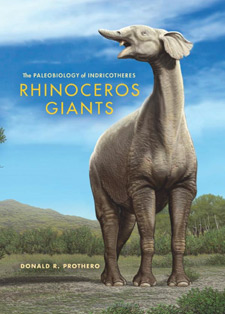by
Donald Prothero, Aug 20 2014
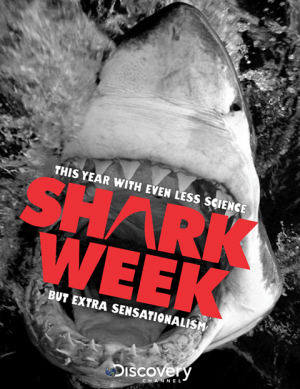
A year ago, I blogged about the decline of “Shark Week” on Discovery Channel. At that time, the normally documentary-filled week that was the channel’s biggest draw all year was beginning to show signs of “jumping the shark.” As I pointed out in previous posts, the deregulation of the airwaves in the late 1980s has led to a steady “network decay” of once reputable TV channels. When cable TV first expanded into hundreds of speciality channels, they were all dedicated to a core mission, whether it be golf or history or science. As TVTropes.com explains it, all of these deregulated cable networks had to please advertisers, and soon moved into reality shows and sensationalism to attract the core audience of 18-31 year old males that advertisers covet. Discovery Channel used to run almost non-stop documentary footage, and did fine like that for over a decade. As TVTropes.com puts it:
The Discovery Channel still shows plenty of actual documentary material, despite having been decaying for almost as long as MTV has. In the late 80s the lineup was mostly serious documentaries, the most famous of which was Wings (no relation to the sitcom except for a focus on aircraft) but which also included classy repackaged BBC imports like Making of a Continent — and once a year there was Shark Week, which was just what you’d expect. By the mid-1990s, they showed an obscene amount of home improvement shows and cooking shows aimed at stay-at-home moms (enough to spawn the spin-off Discovery Home & Leisure Channel, now Planet Green) and Wings had proven so popular it had been farmed out to its own spin-off, Discovery Wings Channel (now Military Channel). Now, they’re being swamped with “guys building and/or blowing things up” shows in the vein of MythBusters and Monster Garage. And about four different shows about ghost hunters. In 2005, Discovery debuted Cash Cab, a game show that takes place in the back of a cab, leaving one unsure whether it even has a theme beyond “non-fiction”. It gets weird when you realize that they’re knocking some of their own shows off, especially Mythbusters into Smash Lab (with a focus on safety measures) and How It’s Made into Some Assembly Required. The latter has almost only done products featured in the former (though How It’s Made has been on for just about ten years, so it’s hard to find something they haven’t done). The Discovery Channel also used to contain a lot of nature, which is where the now-classic Shark Week (which they still air regularly) originated from. But it seems that explosions have taken the place of tigers ripping stuff to pieces. Most of the nature shows have since been relegated to Animal Planet. Amusingly enough, despite the slippage over the years it remains the sole survivor of the educational channels on American cable television.
Continue reading…
comments (8)
by
Donald Prothero, Nov 06 2013
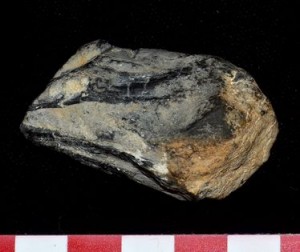
The alleged “fossil kraken beak” touted by McMenamin as the beak of the giant kraken responsible for arranging ichthyosaur bones into art. The scale is in centimeters, so it is only 5 cm long, too small to belong to any giant squid. In addition, the preservation and other details of the specimen do not resemble a cephalopod beak but some other rock or concretion.
Readers of this blog might remember a post two years ago, when I reported on the notorious crackpot paleontologist Mark McMenamin, and his claim that the ichthyosaur skeletons at Berlin-Ichthyosaur State Park in southwest Nevada were artistically arranged by some sort of huge “Kraken” squid. As I detailed in my post, the claim was laughably incompetent and ridiculous. McMenamin claimed that the arrangement of the vertebrae appeared to be deliberate, an arrangement satisfying the “artistic sense” of the giant squid. Clearly he does not know enough about the decay processes of vertebrate skeletons, which frequently leave the vertebral centra either lined up, or toppled over in rows just like we see in the Nevada ichthyosaurs. I vividly remember the buzz at the Geological Society of America (GSA) meeting in 2011, where McMenamin gave his presentation and people were openly laughing at its totally ridiculous claims—or not sure whether they were unwittingly part of an episode of “Punked” and Ashton Kutcher was going to pop out any moment. We all figured it was just another crazy idea by a notorious fringe scientist, and wrote it off to carelessness on the part of the committee that programmed the abstracts (they don’t really have the option of reviewing or rejecting them unless the abstract violates the basic formatting guidelines). The only sad consequence of this whole sordid episode is that the press and internet jumped all over this half-baked story, giving it all sorts of unwarranted coverage. As usual, the media don’t know (or don’t care) that meeting abstracts are unreviewed. They should not be given a lot of press coverage until they are peer reviewed and published. But in this age of 24/7 media coverage of junk, any sensational claim will make the news without any review or background checking or fact checking whatsoever—so McMenamin got his 15 minutes of fame for spewing junk science. Continue reading…
comments (3)
by
Donald Prothero, May 29 2013
As the largest land mammal that has ever lived, there is much fascination with maximum body size and weight estimates for extinct indricotheres. Most often you see sources parroting each other around a common estimate of 20 metric tonnes (20,000 kg), although Alexander (1989) estimated 34 tonnes and Savage and Long (1986) quoted 30 tonnes. Prothero and Schoch (2002) followed Alexander (1989) and used the number of 34 tonnes, and there have been a wide range of estimates all over this range. As Fortelius and Kappelman (1993) showed, these estimates came from some questionable assumptions and extrapolations by Osborn, Granger, and Gregory based on their partial skeleton. That skeletal reconstruction is a composite, a chimaera based on bones from individuals of at least four different size classes, so it is not a very reliable source for the body size of an actual animal.
Most of the weight estimates are based on the combined head and body length (HBL) of the animal, which may be exaggerated if Granger and Gregory’s (1935, 1936) reconstruction drawn by Helen Ziska is inaccurate. As Fortelius and Kappelman (1993, Table 1) showed, different authors estimated a wide range of HBL values, from Gromova’s estimate of 740 cm, to Granger and Gregory’s (1936) maximum of 870 cm, which drops to 621 cm if you use just the smallest individuals. Using the weight equations of Damuth (1990) for converting HBL to mass, this gives weight estimates from as low as 8.4 tonnes (in the smallest specimens) to 24 tonnes in the largest specimens. Continue reading…
comments (2)
by
Donald Prothero, Apr 10 2013
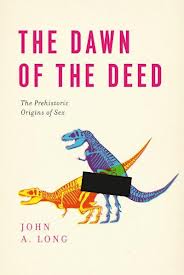
A review of The Dawn of the Deed: The Prehistoric Origins of Sex, by John A. Long (University of Chicago Press, Chicago, 2012).
As I mentioned in last week’s post, we all know that subjects like sex and dinosaurs are guaranteed to get the public’s attention and interest, no matter what story you want to promote. Paleontologist and author Dr. John A. Long (formerly the Vice-President of Research and Collections at the Natural History Museum of Los Angeles County, but now back home in Australia as the Strategic Professor in Palaeontology at Flinders University in Adelaide) has cleverly woven a story about the wild sex lives of the animals kingdom as a hook to talk about his own research into the fossil fish (especially an extinct group called placoderms), which show the first evidence of internal fertilization, the oldest known vertebrate embryos, and the first copulatory structures.
One would think that a story about small extinct placoderms in nodules from the deserts of Western Australia would be a hard sell for a popular book, but Long pulls off the feat with aplomb. The heart of the book is filled with Long’s excitement about this research as he finds and uncovers these amazingly 3D fish fossils from the nodules of the Gogo beds, then compares them with fossils described from collections elsewhere in the world. He soon discovers that mysterious structures that were misidentified or ignored by previous fish paleontologists are actually pelvic claspers (long rodlike structures also found in the pelvic fins of modern sharks to aid them in copulation with females). Then he and his colleagues discover traces of tiny bones inside an adult placoderm that were misidentified as their last meal, but turn out to be embryos. We follow Long’s story as he works on this research until is it is accepted to be published in top journals like Nature. The discovery gets global coverage, and Long even takes part in big media events with a live uplink between the announcement in Australia and Queen Elizabeth of England (in a chapter called “Announcing Fossil Sex to the Queen”). Continue reading…
comments (2)
by
Donald Prothero, Feb 13 2013
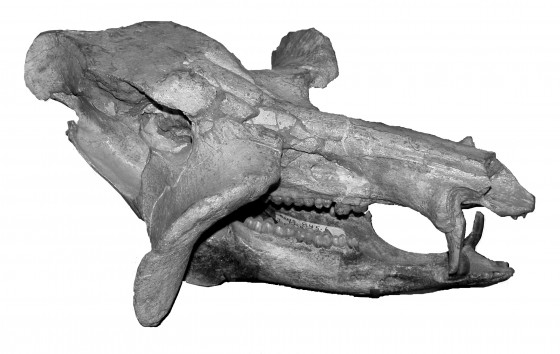
The spectacular skull and jaws of the extinct Miocene peccary Skinnerhyus shermerorum, on display in the fossil mammal hall of the American Museum in New York.
What’s in a name? A rose by any other name would smell as sweet
—William Shakespeare, Romeo and Juliet
The science of classifying organisms is known as taxonomy (Greek, “laws of order”); any named grouping of organisms (a species, a genus, etc.) is called a taxon (plural, taxa). Deciding how to name a new species and genus may seem to be a highly specialized, legalistic dimension of biology and paleobiology, not nearly as glamorous as ecology or behavior or physiology. But taxonomy is not just naming species, because species and higher taxa reflect evolution. Taxonomists do much more than label dusty jars in a museum. They are interested in comparing different species and deciding how they are related and ultimately in deciphering their evolutionary history. They look at the diversity of organisms in time and space and try to understand the large-scale patterns of nature. They look at the present and past geographic distributions of organisms and try to determine how they got there. In short, they look at the total pattern of natural diversity and try to understand how it came to be. Contrary to stereotypes, they are among the most eclectic of biologists and paleobiologists. Continue reading…
comments (2)
by
Donald Prothero, May 23 2012
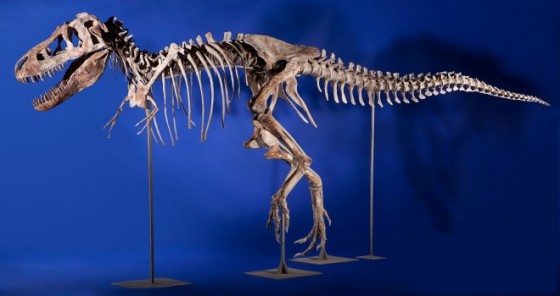
The Mongolian tyrannosaur specimen that was to be auctioned off on May 20.
The buzz was going back and forth among my paleontologist colleagues for weeks: an important tyrannosaur skeleton (Tarbosaurus bataar) that had been poached from Mongolia was scheduled to auctioned off on May 20 in New York City. We paleontologists were all outraged, and spent days signing online petitions, blogging, and sending letters and emails to the appropriate parties, but the tiny scientific community of vertebrate paleontologists in the U.S. (no more than 2000 people) don’t hold any real positions of power beyond a handful of museum curator positions and top professorships. But our activity got the attention of the Mongolian government, and they sent formal letters of protest to the auction house and the American government. All the emails and blog posts were full of anger and despair that such blatant theft could be rewarded with a million-dollar sale. Then, just hours before the auction was to start, a Texas judge issued a Temporary Restraining Order, and it appeared that the the fate of the Mongolian tyrannosaur was put on hold. But the auction house went ahead with the sale anyway, getting a final bid over over $1 million, and arguing that the Texas judge has no jurisdiction over a New York auction house. This occurred, even as the attorney for the Mongolian government was in the auction room with the Texas judge on his cell phone, trying to make himself heard and to get anyone to listen to the judge. The sale went on pending resolution of legal issues, so now it is in limbo for a while until this could be sorted out.
This story highlights a much bigger problem that most people never hear about: the huge international market in stolen fossils and antiquities. Bit by bit, some governments are becoming better at protecting their national treasures, but the poachers and smugglers are always much better funded and quicker than even Interpol. Not only is there a big black-market trade in stolen artwork and artifacts, but the market in natural objects is equally brazen and profitable. The stories I’ve heard just want to make you cry! Now that all five species of rhinoceros are nearly extinct in the wild, mounted rhino heads in older natural history museums all over Europe have been stolen or defaced just for their valuable rhinoceros horn (worth more than cocaine or gold by the ounce, all because “traditional Chinese medicine” believe rhino horn reduces fever). Famous fossil localities in protected national parks all over the world are brazenly poached by thieves, destroying not only most of the fossils but ruining the locality for its scientific value as well. Museum research collections and even specimens on public display with security guards and video cameras protecting them are stolen or damaged by thieves. One-of-a-kind fossils that are certainly new species and genera and have the potential to revolutionize our understanding of life’s history are seen briefly and then end up on some rich person’s living room. (Lately, one of the biggest problems is the fad among rich Hollywood celebrities like Nicholas Cage and Leonardo di Caprio to have their own dinosaur in their living room). Even above-board organizations like some major auction houses and the more reputable fossil dealers have to be careful of poached specimens with fraudulent locality data hiding the illegality of their collection. I’ve heard the horror stories from my colleagues who had the proper permits and found an important bone bed on Federal land, only to come back a few days later and someone had plundered the best material and left the rest in broken piles, hacked out of the ground with no attempt to protect the fossil in a jacket—or record the location and stratigraphic horizon of the specimen, which is a big part of its scientific value. It’s common practice now to bury your excavation and hide it once you leave so this doesn’t happen, and I’ve had museums ask me to not publish my GPS coordinates of paleomagnetic sites that also might give away locations of fossil localities. My paleontologist friends in the fossil-rich National Parks are constantly having to spend more and more time planning on how to prevent poaching, and less time doing the science they are better qualified to do. The situation on private land is even messier: although it is usually legal to collect on most privately-held ranches with the consent of the landowner, the story of the tyrannosaur named “Sue” showed that handshake agreements, and disputes over where the specimen was found, and unclear property rights can make those specimens a legal nightmare. Continue reading…
comments (11)
by
Donald Prothero, Mar 07 2012
Last Feb. 11, the day before Darwin’s 203rd Birthday, I was invited by Ross Blocher and Carrie Poppy of the “Oh, no, it’s Ross and Carrie” podcast to accompany them, along with Emery Emery and Heather Henderson of the Ardent Atheist podcast, to visit the Creation Museum in Santee, east of San Diego, California (videoblog available here). This museum was originally built by the Institute of Creation “Research” (ICR), once led by the late Henry Morris and Duane Gish, which has since relocated to Texas. At one time ICR was the leading creationist organization in the U.S., but lately they seem to have lost their influence (they couldn’t even get their school accredited in conservative Texas!). Now they are overshadowed by Ken Ham of Answers in Genesis and his multi-million-dollar creation museum in Petersburg, Kentucky (which I saw back in 2009). When ICR left California, they sold their museum to Tom Cantor, who made his fortune with a biotech firm, Scantibodies Laboratory, Inc. Cantor bills himself as a Jew converted to creationism, and gives away free DVDs of his story (complete with the Dome of the Rock in Jerusalem in the background) subtitled “A Message of Hope and Gladness for the Jewish people”! With the new ownership, the drab building in an industrial park that long housed the creation museum is now shared with Scantibodies. In one of the many ironies of the place, Scantibodies Inc. makes antibodies, blockers, serum, plasma, and other medical kits, all of which demonstrate the process of evolution in action, and require evolutionary principles to work with….
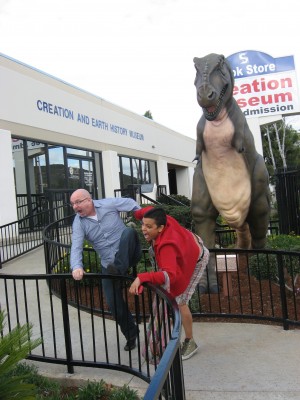
Emery Emery and Heather Henderson mug in front of the tail-dragging T. rex in front of the drab industrial building that houses the museum.
You arrive and drive through heavy black iron gates and walk past a few cheesy dino sculptures in front. These include a miniature T. rex based on the outdated concept with tail dragging behind it. (At least they don’t claim that the predatory dinos ate coconuts. not meat, with their long sharp teeth, as Ken Ham’s museum does). There is a Galapagos tortoise model, a small ankylosaur, and a replica of a dinosaur egg nest, with the false statement that dinosaurs did not take care of their young (long ago debunked by Jack Horner’s Maiasaura nests in Montana). Once inside, there is a lobby with a reception desk and a gift shop which has more products from Ken Ham’s organization than it does from the old ICR gang. The docent that Ross and Carrie wanted to interview was already inside giving a tour, so we headed right in.
Continue reading…
comments (34)
by
Brian Dunning, Dec 08 2011
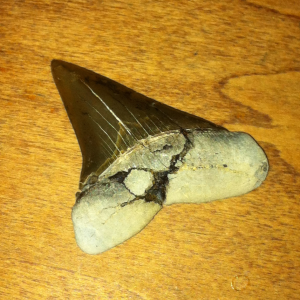 This shark tooth has a very surprising history.
This shark tooth has a very surprising history.
It is from an extinct Giant Mako shark (Isurus hastalis) that died in the early Miocene epoch, at least 5,000,000 years ago. The shark’s remains settled into the silt that later became part of the Monterey formation in what is now Newport Beach, CA.
A long time later in 2006, my friend and chainmaille artist Chris Perley was poking around there for fossils. He’s found some 100 shark teeth of various species in this same spot, a well-known rocky promontory in town that probably wouldn’t benefit from this particular kind of publicity. But that’s not the surprising part. Continue reading…
comments (8)
by
Donald Prothero, May 11 2011
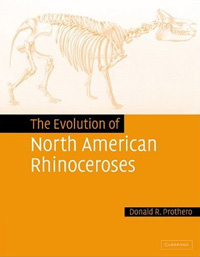
I am a vertebrate paleontologist. I have collected fossil bones out in the Big Badlands of South Dakota and many other places all over the western United States. Although I have collected plenty of dinosaur fossils, I don’t do research on them, but on fossil mammals that are equally cool, including North American rhinoceroses, horses, camels, musk deer, peccaries, and a number of extinct groups that only another mammalian paleontologist would recognize, such as oreodonts and dromomerycids.
People seem to think that my primary job is to collect new fossils and describe them, but in most cases, this is not true. I could spend dozens of man-years getting sunburned in the desert, and not find but a few really scientifically important specimens. Luckily for me and many other paleontologists, there have been many collectors over the past century who have done the hard work in the field, building up large collections in the major museums. What has been missing for a long time is people who want to spend the months and years figuring out what these new fossils are, describing and publishing them, and giving us a correct and up-to-date picture of what fossil animals lived when and where. This is called systematics, and although it’s not as glamorous as the “Indiana Jones”-“Jurassic Park” image of paleontology that most people think of, it is the most important job in paleontology. Without hundreds of hours of careful work in museums, measuring and studying and photographing and then publishing the fossils in highly specialized monographs that only a few people can understand, all the computer-driven arm-waving about how many species lived at a given time, or what caused their extinction (all based on outdated names or incorrect identifications) is “garbage in, garbage out.”
Continue reading…
comments (13)
by
Michael Shermer, Dec 21 2010
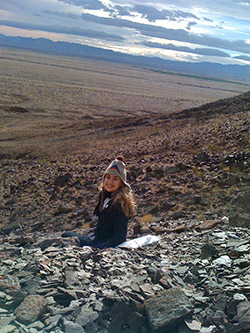
click to enlarge photo
This past weekend, December 17–19, 2010, I joined paleontologists Donald Prothero from Occidental College and John Long from the Natural History Museum of Los Angeles County on a fossil hunting, rock hopping, geology viewing, petroglyph scanning excursion through the Mojave Desert between Los Angeles and Las Vegas. Through the entire trip I kept thinking “I wish the creationists and Intelligent Design theorists would try their hand at some actual field work because then they would see (and hear and smell and especially touch) what nature is really like and what the history of life reveals in the rocks, instead of sitting in an air-conditioned or heated office in some think tank building or school of theology department, trolling through published papers by real scientists who do this field work, trying to find some little gap that must be filled by the creating designer. Continue reading…
comments (26)



